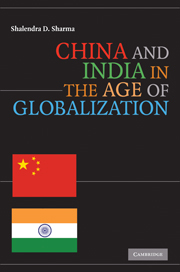Book contents
- Frontmatter
- Contents
- Acknowledgments
- Acronyms
- Political Map of China
- Political Map of India
- Introduction: China and India in the Age of Globalization
- 1 Prelude to Globalization: China (1949–1978) and India (1947–1991)
- 2 China and India Embrace Globalization
- 3 China: Strategies and Patterns of Global Integration
- 4 India: Strategies and Patterns of Global Integration
- 5 Sino-Indian Relations: Partners, Friends, or Rivals?
- 6 India and the United States: From Estrangement to Engagement
- 7 The Rise of China and Its Implications for the United States
- 8 China and India: Future Challenges and Opportunities
- Bibliography
- Index
1 - Prelude to Globalization: China (1949–1978) and India (1947–1991)
Published online by Cambridge University Press: 22 January 2010
- Frontmatter
- Contents
- Acknowledgments
- Acronyms
- Political Map of China
- Political Map of India
- Introduction: China and India in the Age of Globalization
- 1 Prelude to Globalization: China (1949–1978) and India (1947–1991)
- 2 China and India Embrace Globalization
- 3 China: Strategies and Patterns of Global Integration
- 4 India: Strategies and Patterns of Global Integration
- 5 Sino-Indian Relations: Partners, Friends, or Rivals?
- 6 India and the United States: From Estrangement to Engagement
- 7 The Rise of China and Its Implications for the United States
- 8 China and India: Future Challenges and Opportunities
- Bibliography
- Index
Summary
When India gained independence in 1947 following more than two centuries of British colonial rule and the Chinese Communist Party took control of the Chinese mainland in 1949 after a protracted civil war, both were among the poorest nations on earth. In 1951, some 85 percent of China's population out of an estimated 540 million was classified as rural, and in India, more than 90 percent of the total population of approximately 360 million lived in the countryside. Moreover, both countries had roughly the same level of GNP per capita income ($50 for China and $60 for India in 1952 U.S. dollars) and had experienced similar slow and stagnant economic growth rates in the previous half century. Basic standard-of-living indicators such as life expectancy (only thirty-two years in India and forty years for China), infant mortality rates, nutritional and consumption patterns, and access to education, health care, and social services were also extremely poor to nonexistent. In such impoverished environments, infectious diseases such as malaria, cholera, smallpox, leprosy, and dysentery were rampant, and frequent epidemics and famine took their deadly toll on weak and vulnerable populations (Maddison 2003; Sachs 2005, chaps. 8–9; Sen 1982; World Bank 1983). In sum, both nations faced formidable challenges to economic development and nation-building. The following sections discuss the paths each country followed to achieve its developmental goals and assesses the outcomes, legacies, and political and socioeconomic implications.
- Type
- Chapter
- Information
- China and India in the Age of Globalization , pp. 13 - 53Publisher: Cambridge University PressPrint publication year: 2009

